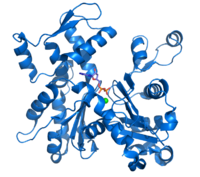
Photo from wikipedia
Simple Summary It is well known that actin forms a cytoplasmic network of microfilaments, the part of the cytoskeleton, in the cytoplasm of eukaryotic cells. The presence of nuclear actin… Click to show full abstract
Simple Summary It is well known that actin forms a cytoplasmic network of microfilaments, the part of the cytoskeleton, in the cytoplasm of eukaryotic cells. The presence of nuclear actin was elusive for a very long time. Now, there is a very strong evidence that actin plays many important roles in the nucleus. Here, we discuss the recently discovered functions of the nuclear actin pool. Actin does not have nuclear localization signal (NLS), so its import to the nucleus is facilitated by the NLS-containing proteins. Nuclear actin plays a role in the maintenance of the nuclear structure and the nuclear envelope breakdown. It is also involved in chromatin remodeling, and chromatin and nucleosome movement necessary for DNA recombination, repair, and the initiation of transcription. It also binds RNA polymerases, promoting transcription. Because of the multifaceted role of nuclear actin, the future challenge will be to further define its functions in various cellular processes and diseases. Abstract Actin is one of the most abundant proteins in eukaryotic cells. There are different pools of nuclear actin often undetectable by conventional staining and commercial antibodies used to identify cytoplasmic actin. With the development of more sophisticated imaging and analytical techniques, it became clear that nuclear actin plays a crucial role in shaping the chromatin, genomic, and epigenetic landscape, transcriptional regulation, and DNA repair. This multifaceted role of nuclear actin is not only important for the function of the individual cell but also for the establishment of cell fate, and tissue and organ differentiation during development. Moreover, the changes in the nuclear, chromatin, and genomic architecture are preamble to various diseases. Here, we discuss some of the newly described functions of nuclear actin.
Journal Title: Biology
Year Published: 2021
Link to full text (if available)
Share on Social Media: Sign Up to like & get
recommendations!